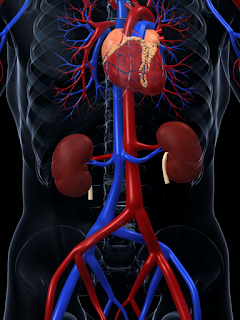Up to 80% of patients with low glomerular filtration rates (GFR), and in the absence of acute coronary syndromes or congestive heart failure, have positive values for TnT, regardless of whether or not they receive dialysis treatment.
On the other hand, one large study that included more than 700 patients found the prevalence of TnI to be only 0.4-6% depending on the cut-off value chosen .
These results suggest that a positive TnT may represent a common and benign incidental finding in patients with impaired renal function, whereas a positive TnI occurs only in the setting of an acute coronary event.
Tsutamoto et al. performed a very elegant study measuring the transcardiac TnT gradient by measuring levels in both the aortic root and coronary sinus . They classified 258 patients with congestive heart failure as having either normal or low GFR. Despite the finding of markedly elevated levels of TnT in the patients with low GFR compared to the patients with normal renal function, the transcardiac gradient appeared similar between the two groups. They concluded that the elevated TnT observed in patients with a low GFR occurs as a result of accumulation rather than increased myocardial injury.
However, other studies have demonstrated consistent associations between elevated TnT and hard endpoints such as death and myocardial infarction .
Therefore, although chronic kidney disease appears to be nonspecifically associated with positive TnT values, the absolute TnT level may serve as a useful prognostic marker.
In conclusion, evidence suggests that the kidneys clear TnT and thus baseline levels may indeed rise in the setting of a low GFR. Conversely, it appears that elevated TnI values represent myocardial injury in both patients with low GFR and other populations
Aksoy N, Ozer O, Sari I, Sucu M, Aksoy M, Geyikli I. Contribution of renal function impairment to unexplained troponin T elevations in congestive heart failure. Ren Fail 2009, 31(4):272-7.
Ammann P, Maggiorini M, Bertel O, Haenseler E, Joller-Jemelka HI, Oechslin E, Minder EI, Rickli H, Fehr T. Troponin as a risk factor for mortality in critically ill patients without acute coronary syndromes. J Am Coll Cardiol 2003, 41(11):2004-9.
Apple FS, Murakami MM, Pearce LA, Herzog CA. Predictive value of cardiac troponin I and T for subsequent death in end-stage renal disease. Circulation 2002, 106:2941-5.
Aviles RJ, Askari AT, Lindahl B, Wallentin L, Jia G, Ohman EM, Mahaffrey KW, Newby LK, Califf RM, Simoons ML, Topol EJ, Lauer MS. Troponin T levels in patients with acute coronary syndromes, with or without renal dysfunction. N Engl J Med 2002, 346(26):2047-52
Tsutamoto T, Kawahara C, Yamaji M, Nishiyama K, Fujii M, Yamamoto T, Horie M. Relationship between renal function and serum cardiac troponin T in patients with chronic heart failure. Eur J Heart Fail 2009, 11(7):653-8
On the other hand, one large study that included more than 700 patients found the prevalence of TnI to be only 0.4-6% depending on the cut-off value chosen .
These results suggest that a positive TnT may represent a common and benign incidental finding in patients with impaired renal function, whereas a positive TnI occurs only in the setting of an acute coronary event.
Tsutamoto et al. performed a very elegant study measuring the transcardiac TnT gradient by measuring levels in both the aortic root and coronary sinus . They classified 258 patients with congestive heart failure as having either normal or low GFR. Despite the finding of markedly elevated levels of TnT in the patients with low GFR compared to the patients with normal renal function, the transcardiac gradient appeared similar between the two groups. They concluded that the elevated TnT observed in patients with a low GFR occurs as a result of accumulation rather than increased myocardial injury.
However, other studies have demonstrated consistent associations between elevated TnT and hard endpoints such as death and myocardial infarction .
Therefore, although chronic kidney disease appears to be nonspecifically associated with positive TnT values, the absolute TnT level may serve as a useful prognostic marker.
In conclusion, evidence suggests that the kidneys clear TnT and thus baseline levels may indeed rise in the setting of a low GFR. Conversely, it appears that elevated TnI values represent myocardial injury in both patients with low GFR and other populations
Aksoy N, Ozer O, Sari I, Sucu M, Aksoy M, Geyikli I. Contribution of renal function impairment to unexplained troponin T elevations in congestive heart failure. Ren Fail 2009, 31(4):272-7.
Ammann P, Maggiorini M, Bertel O, Haenseler E, Joller-Jemelka HI, Oechslin E, Minder EI, Rickli H, Fehr T. Troponin as a risk factor for mortality in critically ill patients without acute coronary syndromes. J Am Coll Cardiol 2003, 41(11):2004-9.
Apple FS, Murakami MM, Pearce LA, Herzog CA. Predictive value of cardiac troponin I and T for subsequent death in end-stage renal disease. Circulation 2002, 106:2941-5.
Aviles RJ, Askari AT, Lindahl B, Wallentin L, Jia G, Ohman EM, Mahaffrey KW, Newby LK, Califf RM, Simoons ML, Topol EJ, Lauer MS. Troponin T levels in patients with acute coronary syndromes, with or without renal dysfunction. N Engl J Med 2002, 346(26):2047-52
Tsutamoto T, Kawahara C, Yamaji M, Nishiyama K, Fujii M, Yamamoto T, Horie M. Relationship between renal function and serum cardiac troponin T in patients with chronic heart failure. Eur J Heart Fail 2009, 11(7):653-8

Comments
Post a Comment